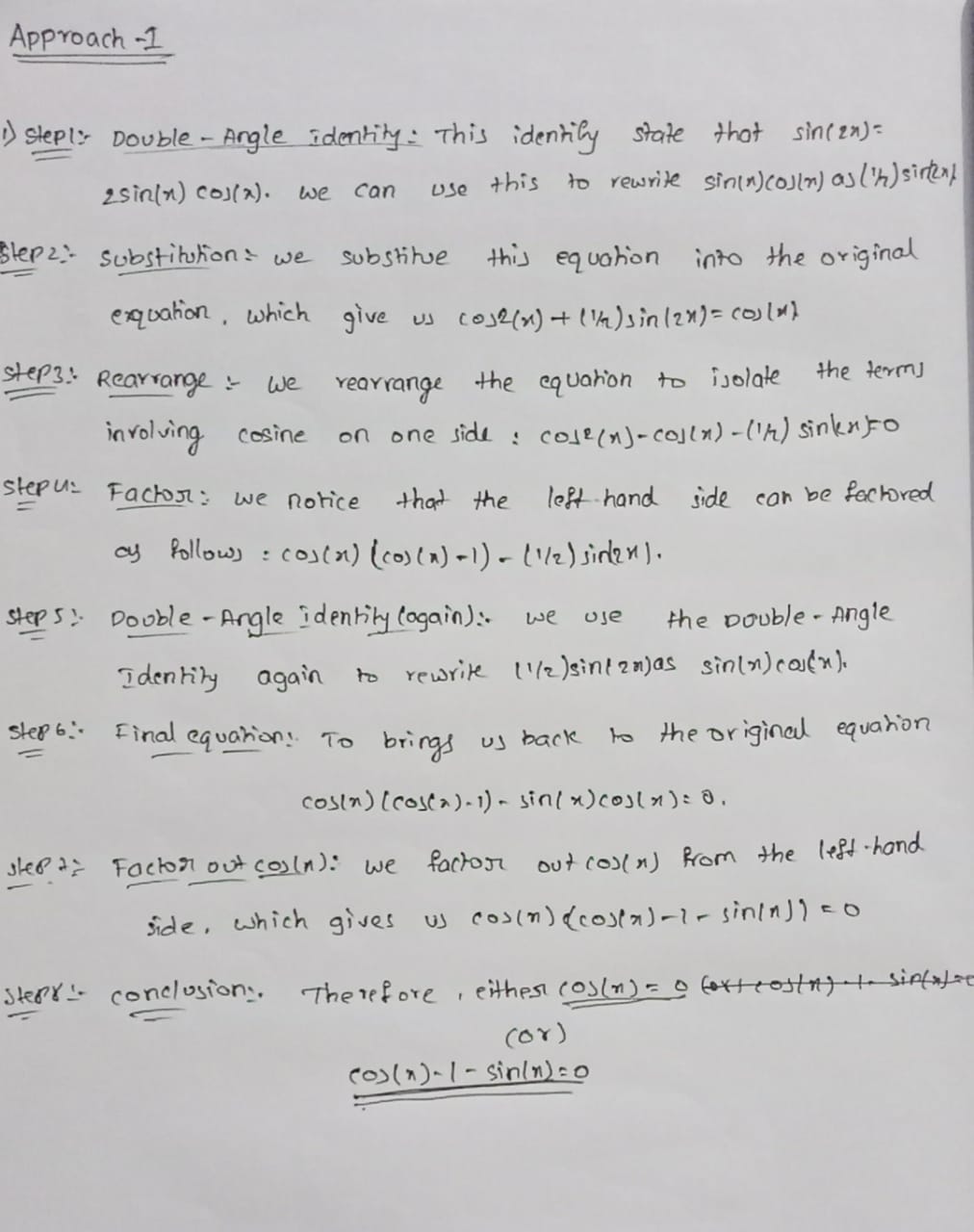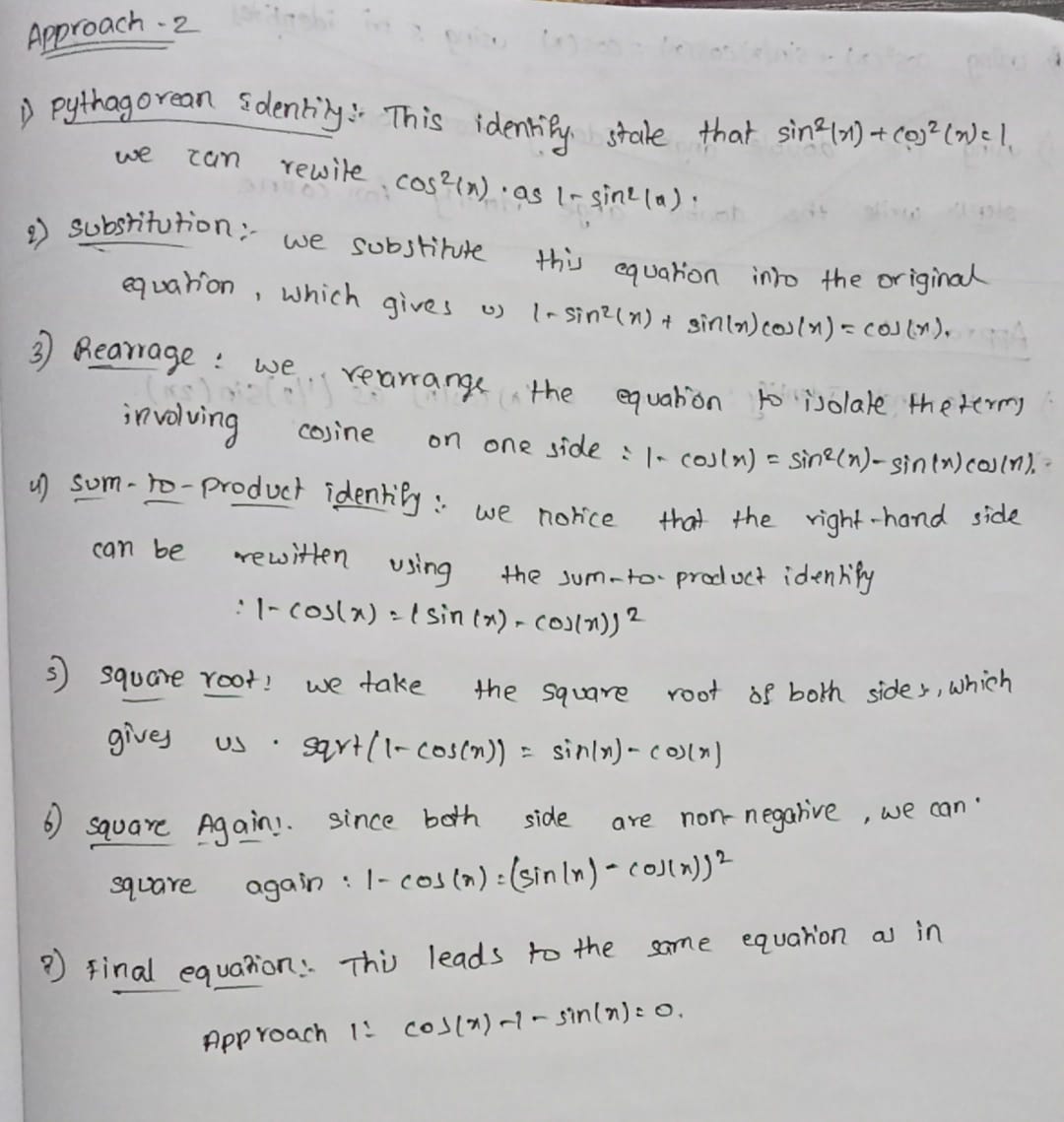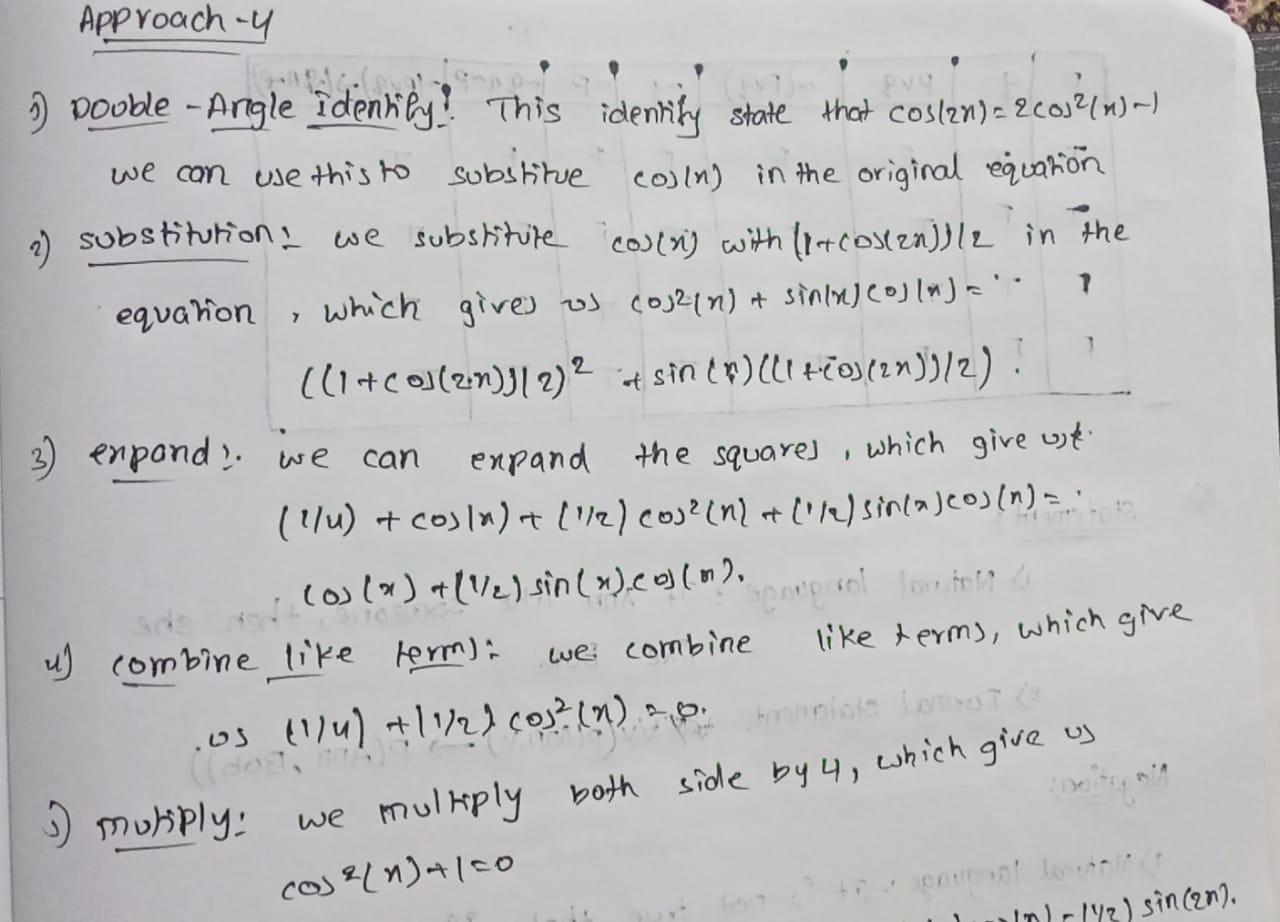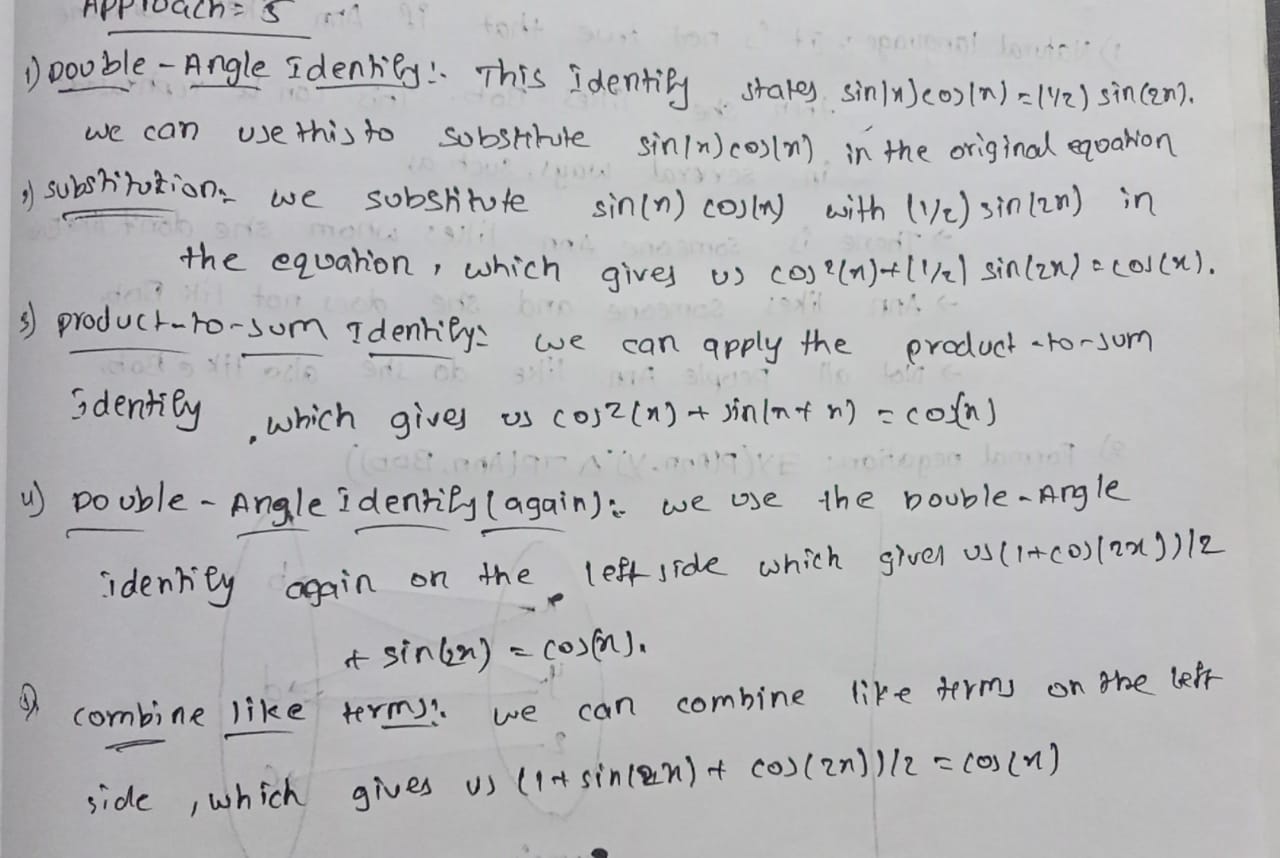Answered step by step
Verified Expert Solution
Question
1 Approved Answer
I need help solving the trig equation cos^2(x)+sin(x)cos(x)=cos(x) using 5 different trig identities Approach - 1 1) step!: Double - Angle identity: This identity state
I need help solving the trig equation cos^2(x)+sin(x)cos(x)=cos(x) using 5 different trig identities




 Approach - 1 1) step!: Double - Angle identity: This identity state that sincen)= 2sin(n) cosix). we can use this to rewrite sinin)cosing as ('h)sirtent step 2 " substitutions we substituenthis equation into the original exquation, which give us cos2 ( x) + (1/) sin/241)= colm) step3! Rearrange: we rearrange the equation to isolate the terms involving cosine on one side : cose (n)-colly) - ( 1) sinksto stepus Factor: we notice that the left hand side can be factored cy follows : cosco) ( cos (x) - 1 ) - (1/2) sinden). steps : Double - Angle identity (again):. we use the Double - Angle Identity again to rewrite (1/2 ) sintznj as sin(n) could). step6: . Final equations. To brings us back to the original equation cosin ) ( costa ) - 1) - sin( x) cosln ) = 0. step At Factor out cosl n): we factors out cos(n) from the left -hand side, which gives us cosin) ( costa)- 1 - sinin) ) EO step- conclusion. Therefore , eithes cos( n) = 0 text costing to sirlater (or ) cos ( x ) - 1 - sin( n ) : 0Approach - 2 1 pythagorean identity : This identify state that singly) + cos? ( wel, we can rewile coszin). as In singla) ; ") substitution : we substitute this equation into the original equation , which gives us Insinzin) + sinla) cooln) = cosky). 2) Rearrage: we rearrange,,the equation to isolate, theterm involving cosine on one side : 1- cosln) = sing(n) - sinta) couln). " sum- to-product identity: we notice that the right-hand side can be rewitten using the sum-to product identify : 1 - cosla ) = ( sin (x ) - coolm) ) 2 s) square root! we take the square root of both sides, which gives us . sqrt ( 1 - cosco)) = sinly) - cooln) 6) square Again!. since both side are non- negative, we can' square again : 1- cos ( ) = ( sinln) - colla) ) 2 ?) Final equation: This leads to the same equation as in Approach 1: cos (* ) -1 - sin( n) : 0.Approach -3 () confunction identity!. From the cofunction identity, sin (90'-n) = co) (n ) . 2) substitution: substitute sin (in) with sin (90-a) in the equation : cos= (n ) + cos (x ) sin(goin)= coming. " Quip 3) produch - to - sumidentity. using the product - tor sum identity rewrite cosing sin(go -. ") as sin (at 90) = sin ( 180 -i),popp ") periodicily of sines since sine is a periodic function with period 360, sin( (80'- ) : sin (8). her.. 3) Rearrange! substituentack and rearrange : coj2 ( a) + sin( 21) = (@ (x) 6) " solate rosin): cos? (m) - cos( m) + sinla) co. ?) Factor : Factor the left -hand side : costa) / coll x ). 1 ) - sirly ).0Approach - y ") Double - Angle identify! This identify state that coslin)= Eco,2 ( ) -) we can use this to substituentosing in the original equation ") substitution: we substitute "cosing with (i coskenji/2 in the equation , which gives us coszin) + sini, colla) = '. ( ( 1 + cos ( zin ) j / 2) 2 .it sin ($ ) ((1+ cos( in> >/2). 3) expand? we can expand the squares, which give ust. (1/4) + cosin) it (1/2) cos?(Al + (ike ) sin(a )eos ( n) =. los ( x ) + ( 1 / 2) sin ( * ) cos (n ). ") combine like term): we combine like terms, which give . OS ( 1 1 4) + 1 1/21 cos ? ( n) 20. hanniole Long? ( 3) muliply: we multiply both side by 4, which give us cos ? ( n) + 150 In )-1yz ) sincen).Approach : 3 " Double - Angle Identity: This Identify,states, sinly)eosin) = 1/2) sin (En). we can use this to substitute sinIn) cooln) in the original equation ") substitution, we substitute sin(n) cosly with (1/2 ) sinkin) in the equation, which gives us cos?(n)+ 1//z) sin(in) : cos(x). 5) product- to-sum Identify we can apply the product -to-jum Identity which gives us cos 2 ( n ) + Jinla f n) = cofn) ") Double - Angle identify (again): we use the bouble- Angle identify again on the left side which gives us ( It ( os ( 201 ) ) 12 it sinks) = cos(al. " combine like terms: we can combine like terms on the left side, which gives us (It sincein) + cos( in) )12 = cos(n)
Approach - 1 1) step!: Double - Angle identity: This identity state that sincen)= 2sin(n) cosix). we can use this to rewrite sinin)cosing as ('h)sirtent step 2 " substitutions we substituenthis equation into the original exquation, which give us cos2 ( x) + (1/) sin/241)= colm) step3! Rearrange: we rearrange the equation to isolate the terms involving cosine on one side : cose (n)-colly) - ( 1) sinksto stepus Factor: we notice that the left hand side can be factored cy follows : cosco) ( cos (x) - 1 ) - (1/2) sinden). steps : Double - Angle identity (again):. we use the Double - Angle Identity again to rewrite (1/2 ) sintznj as sin(n) could). step6: . Final equations. To brings us back to the original equation cosin ) ( costa ) - 1) - sin( x) cosln ) = 0. step At Factor out cosl n): we factors out cos(n) from the left -hand side, which gives us cosin) ( costa)- 1 - sinin) ) EO step- conclusion. Therefore , eithes cos( n) = 0 text costing to sirlater (or ) cos ( x ) - 1 - sin( n ) : 0Approach - 2 1 pythagorean identity : This identify state that singly) + cos? ( wel, we can rewile coszin). as In singla) ; ") substitution : we substitute this equation into the original equation , which gives us Insinzin) + sinla) cooln) = cosky). 2) Rearrage: we rearrange,,the equation to isolate, theterm involving cosine on one side : 1- cosln) = sing(n) - sinta) couln). " sum- to-product identity: we notice that the right-hand side can be rewitten using the sum-to product identify : 1 - cosla ) = ( sin (x ) - coolm) ) 2 s) square root! we take the square root of both sides, which gives us . sqrt ( 1 - cosco)) = sinly) - cooln) 6) square Again!. since both side are non- negative, we can' square again : 1- cos ( ) = ( sinln) - colla) ) 2 ?) Final equation: This leads to the same equation as in Approach 1: cos (* ) -1 - sin( n) : 0.Approach -3 () confunction identity!. From the cofunction identity, sin (90'-n) = co) (n ) . 2) substitution: substitute sin (in) with sin (90-a) in the equation : cos= (n ) + cos (x ) sin(goin)= coming. " Quip 3) produch - to - sumidentity. using the product - tor sum identity rewrite cosing sin(go -. ") as sin (at 90) = sin ( 180 -i),popp ") periodicily of sines since sine is a periodic function with period 360, sin( (80'- ) : sin (8). her.. 3) Rearrange! substituentack and rearrange : coj2 ( a) + sin( 21) = (@ (x) 6) " solate rosin): cos? (m) - cos( m) + sinla) co. ?) Factor : Factor the left -hand side : costa) / coll x ). 1 ) - sirly ).0Approach - y ") Double - Angle identify! This identify state that coslin)= Eco,2 ( ) -) we can use this to substituentosing in the original equation ") substitution: we substitute "cosing with (i coskenji/2 in the equation , which gives us coszin) + sini, colla) = '. ( ( 1 + cos ( zin ) j / 2) 2 .it sin ($ ) ((1+ cos( in> >/2). 3) expand? we can expand the squares, which give ust. (1/4) + cosin) it (1/2) cos?(Al + (ike ) sin(a )eos ( n) =. los ( x ) + ( 1 / 2) sin ( * ) cos (n ). ") combine like term): we combine like terms, which give . OS ( 1 1 4) + 1 1/21 cos ? ( n) 20. hanniole Long? ( 3) muliply: we multiply both side by 4, which give us cos ? ( n) + 150 In )-1yz ) sincen).Approach : 3 " Double - Angle Identity: This Identify,states, sinly)eosin) = 1/2) sin (En). we can use this to substitute sinIn) cooln) in the original equation ") substitution, we substitute sin(n) cosly with (1/2 ) sinkin) in the equation, which gives us cos?(n)+ 1//z) sin(in) : cos(x). 5) product- to-sum Identify we can apply the product -to-jum Identity which gives us cos 2 ( n ) + Jinla f n) = cofn) ") Double - Angle identify (again): we use the bouble- Angle identify again on the left side which gives us ( It ( os ( 201 ) ) 12 it sinks) = cos(al. " combine like terms: we can combine like terms on the left side, which gives us (It sincein) + cos( in) )12 = cos(n) Step by Step Solution
There are 3 Steps involved in it
Step: 1

Get Instant Access to Expert-Tailored Solutions
See step-by-step solutions with expert insights and AI powered tools for academic success
Step: 2

Step: 3

Ace Your Homework with AI
Get the answers you need in no time with our AI-driven, step-by-step assistance
Get Started


